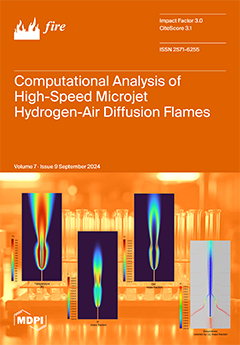In order to reveal the deflagration mechanism of DME/H
2-blended gasses, the micro-mechanism was studied based on the constructed UC San Diego 2016 pyrolysis oxidation mechanism model. The results show that adiabatic flame temperature and laminar flame speed increase with the increase
[...] Read more.
In order to reveal the deflagration mechanism of DME/H
2-blended gasses, the micro-mechanism was studied based on the constructed UC San Diego 2016 pyrolysis oxidation mechanism model. The results show that adiabatic flame temperature and laminar flame speed increase with the increase in the equivalence ratio (
Φ); they first increase and then decrease with the increase in the hydrogen (H
2)-blended ratio (
λ), and with the increase in
λ, the
Φ corresponding to the peak laminar flame speed of the blended gas increases. The addition of H
2 increases the consumption of O
2, and H
2 reacts with CO to form H
2O and CO
2, promoting complete combustion. When
Φ = 1.0–1.2, the equilibrium mole fraction of H and OH-activated radicals reach the maximum, and with the addition of H
2, the concentration of activating radicals gradually increases, while the number of promoted elementary reactions increases by two, and the number of inhibited elementary reactions does not increase. Meanwhile, the addition of H
2 increases the reaction rate of most reactions on the main chemical reaction path CH
3OCH
3→CH
3OCH
2→CH
2O→HCO→CO→CO
2 of DME and increases the risk of the deflagration of DME/H
2-blended gas.
Full article





